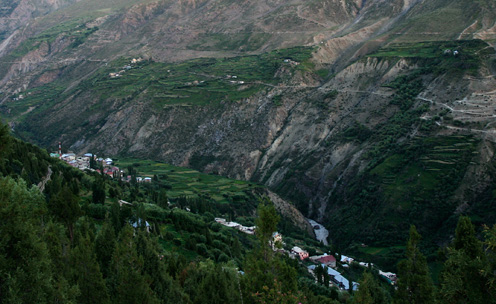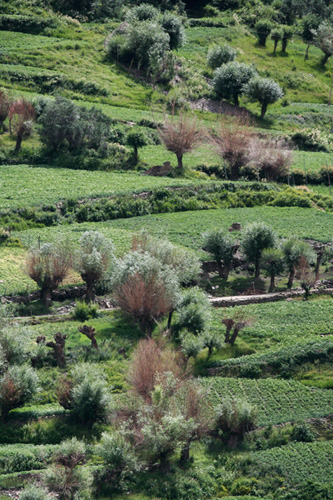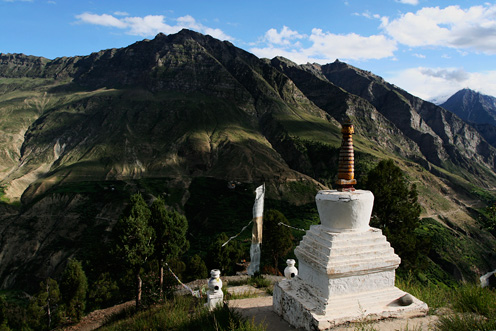The flat terrain and straight roads near Sarchu do not last long. Crossing Tsarap river soon after Sarchu, the road starts climbing suddenly, forming the most dramatic section of the road since leaving Manali. A series of hairpin bends take the vehicles up by more than 1500 feet in less than an hour’s time. Peeping out through the window, what you get is the top view of the vehicles trailing below and layers of roads going back and forth at different heights. Gata loops, as they are called, have more than 20 switchback loops that quickly climb up above 15,000 feet.
At the end of the climb is the views of vast planes of Sarchu far below and the road taken to come up from there. On the other side of the valley are the mountain ranges of Zanskar that do not look very high from where we are standing. A few walking trails go across these mountains that make me wonder what on earth do people do by crisscrossing this barren valley. I would later learn, as I explore the valleys of Zanskar, that it could be one of the trails that emerges out of Zanskar to Sarchu, used by locals as well as trekkers occasionally. Leh – Manali highway may be a barren land but even here, you are never too faraway from people and habitation.
As we climb up the loops, I saw a truck overturned and fallen out of the road. Thankfully it is a relatively flat location and the truck hadn’t taken the plunge into the valley. It seemed to be a very recent accident – the driver of the truck had climbed up on it and was assessing the damages done. The Border Roads Organization that manages these roads was very quick to respond: they had already arrived with a crane and were working out a rescue plan. It did not look like the truck suffered too many damages, and seemed fit enough to continue on the journey once they get it back on the wheels.
For the treacherous mountain roads of Manali-Leh highway, accidents seem to be few and far apart. The rate of accidents seemed much less than what we see along the highways in the plains, where people drive recklessly and get into trouble when they run out of control. But one bad turn and there won’t be much hope for the vehicle and its occupants. Along the entire stretch of the road, I could notice at least half a dozen trucks that took the terrible tumble down the mountain. What remained of them were just skeletons of the frame, after every useful part was removed and taken away – engine, gear assembly and wheels included.
At the top of the Gata loops is Nakeela (altitude – 15,547 feet or 4740 meters), which for some reason is left out from most of the maps and travelogues that I had looked up before taking the route. It is a BRO sign on the top that first introduced me to the pass. The terrain is very dry after Nakeela with no streams or rivers to sight. As if to compensate for it, we witnessed mild snowfall as we drove over the pass, which morphed into a drizzle when we lost some height. The landscape ahead gets monotonous as the road descends into a dry valley and quickly climbs up towards the next pass – Lachlung la (altitude – 16,616 feet or 5065 meters).
There is again some change in the landscape when the road approaches Pang, as life is infused into the scnery from the clear flow a stream – Kangla Jal. It soon widens to appear like a river, flowing next to the army camp and parachute tents of Pang (altitude – 15,200 feet or 4600 meters). Pang’s setup is much different from earlier campsites. Looming far away on the way to Leh are the mountains leading towards the highest pass on the road. Eroded mountain cliffs raise suddenly behind the camps, and in the other direction is Kangla Jal flowing over a rocky bed. Just across the tourist tents is an army camp where a sign proudly proclaims it as the “world’s highest transit camp”.
The road climbs up steadily after Keylong, keeping Bhaga River to the right. It is a deep valley for first half hour of the journey. At Jispa, the next big village, the river widens and the road descends closer to the valley floor. Jispa is another place to break for the night on the way to Leh, popular with private bus operators and with people driving on their own. A few mid range accommodations dot the town, but there are no budget options available.
Not far from Jispa is Darcha, the last round-the-year settlement on the road till you enter Indus Valley. It is nothing more than a bunch of shops lined along the main road and a police check-post for foreigner registration. It is also the last place on the road served by Himachal Parivahan’s local buses.
A small road runs to the left just after Darcha, connecting the villages deep in the mountains with the Manali-Leh highway. It is though this road that trekkers begin the long walk to Zanskar and further to Lamayuru Village in the Indus Valley. The twenty day trek is getting shorter every year, as the BRO is building an all-weather road to connect Darcha with Padum and further to Nyemo Village on the bank of Indus. The progress of construction is slow paced and may take many more years before it traverses over perennially snowbound Shingo La. But the progres is visible, with more than 40km of the road already built between Darcha and Padum. We did not know as we passed Darcha, but this was the path we would choose later to return from Ladakh to Manali.
From Darcha, it is a steady climb for next 40km to Baralacha la, the highest point in the road so far. Trees now disappear completely from the landscape, limiting the vegetation to tiny grass and occasional shrubs. It will be another 8 hours before seeing even a single tree, until the road approaches Indus Valley. Pigeons keep company of travellers in this near lifeless road over the mountains. Besides people, they are the only living beings that show up constantly along the way. They are there atop Baralacha la, and even on Tanglang la – the highest point on the highway, showing up at frequent intervals walking along the road and quickly hopping aside for a brief moment on the approach of a vehicle.
Mountains continue to grow taller and more arid as the road progresses north towards Baralacha la. But for the high peaks that have retained patches of last year’s snow, mountain surface is now in all hues of brown – chocolate brown, muddy brown and at some places reddish brown. Shades of brown are to dominate the landscape for rest of the way.
11km before Baralacha la is Deepak Tal – a lake I have heard of and looking forward to see. It turns out to be a small tank adjoining the road, its waters calm, clear and green. Suraj Tal, another lake at Baralacha is bigger, and stands against a backdrop of views of snowy peaks from the top. The road runs along Bhaga River all the way to the pass where she emerges from the middle of rocks as a small stream. To the other side of these rocks is Suraj Tal, probably connected to the stream through an underground channel.
Descent from Baralacha is quick. At the floor of the valley is awkwardly named Bharatpur City, which is nothing more than half a dozen parachute tents huddled together. Beyond Bharatpur City is the high altitude plateau of Sarchu. It is now one long straight road on a perfectly glat terrain, which feels like an expressway after going through ups and downs of the mountain roads for the whole day. It is now the turn of Yunam River to accompany the traveller till Sarchu.
Sarchu is the next option for breaking the journey. It is higher and colder than Keylong or Darcha, and many people say that it tends to get uncomfortable. The rarefied and dry air can add to the discomfort. At the approach of Sarchu is a line of luxury tents that are managed by HPTDC and a little ahead of them are a bunch of parachute tents.
A few kilometers after Sarchu, the road begins climbing suddenly over a series of switchbacks, adding nearly a kilometer to the altitude in no time.
The mountains raise so high that I have to bend down to have a look at the summits through my hotel window. I can see the bottom of the valley, but the river has carved a gorge for itself deep enough to hide the flow from the view. Lower slopes are green, with square fields of aloo-matar and willows along their edges. But it is brown and barren high up. On the high peaks and depressions of the slopes are bits of snow that have survived the summer.

Keylong’s edifices look tiny against these giant mountains. Allow me some cliche here: standing high on the slopes of one of those mountains, they look like tiny matchboxes spread haphazardly on the floor. The town is a good stopover if you have your own vehicle and travelling to Leh at an easy place. It is not too high a place to sleep, and summers are reasonably warm. The great views are a bonus.

If you are charmed by the views or stuck (like we were) waiting for transportation for the way ahead, there is enough in Keylong to keep you occupied. The two monasteries near the town – Shashur and Kardang – are midway up the mountains on the opposing slopes. Lucky few (again, like we were) may end up arriving here on a day when a festival is on at the monastery. Celebrations here are usually tourist-free, unlike the crowded ones in Ladakh.
Most hotels in town are spread along the mall road. Being a popular stopover, the hotels tend to get full for most of the duration when Manali-Leh highway is open. If you haven’t booked ahead, the next option is to search at the ‘old bus stand’ on the Manali-Leh road, where the hotels tend to have rooms available.

Landing up at Keylong and trying to find transportation for the way ahead can be hard. The luxury buses from Manali usually run full. The uncomfortable Delhi-Leh bus run by Himachal Road Transport Corporation is not exactly the best option, but even that can get filled up quickly. Drokpa Travel on mall road can book private cabs from Keylong or shared taxis leaving from Manali.
Ahead of Keylong, the road gently climbs up along Bhaga Valley and slowly makes its way to no man’s land.


